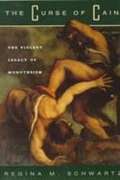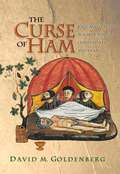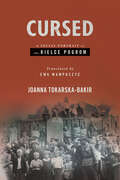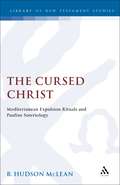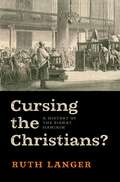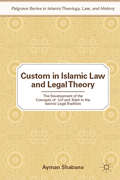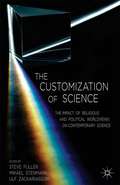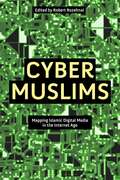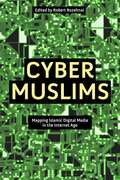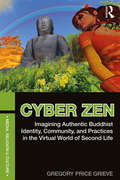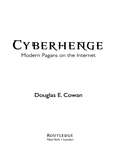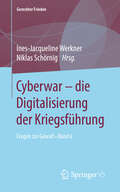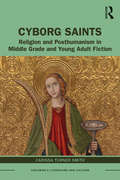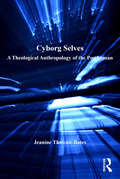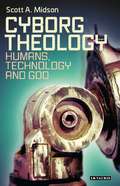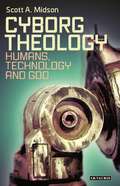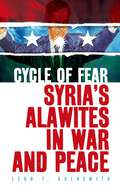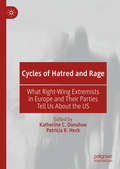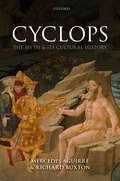- Table View
- List View
The Curse of Cain: The Violent Legacy of Monotheism
by Regina M. SchwartzThe Curse of Cain confronts the inherent ambiguities of biblical stories on many levels and, in the end, offers an alternative, inspiring reading of the Bible that is attentive to visions of plenitude rather than scarcity, and to an ethics based on generosity rather than violence. "[A] provocative and timely examination of the interrelationship of monotheism and violence. . . . This is a refreshing alternative to criticism-biblical and otherwise-that so often confuses interpretation with closure; it is an invitation to an ethic of possibility, plenitude, and generosity, a welcome antidote to violence, as important for its insights into memory, identity, and place as for its criticism of monotheism's violent legacy."—Booklist "Brilliant and provocative, this is a work demanding close attention from critics, theologians, and all those interested in the imaginative roots of common life."—Rowan Williams, Bishop of Monmouth "A stunningly important book."—Walter Brueggemann, Theology Today "Artfully rendered, endlessly provocative."—Lawrence Weschler, New Yorker
The Curse of Ham: Race and Slavery in Early Judaism, Christianity, and Islam
by David M. GoldenbergHow old is prejudice against black people? Were the racist attitudes that fueled the Atlantic slave trade firmly in place 700 years before the European discovery of sub-Saharan Africa? In this groundbreaking book, David Goldenberg seeks to discover how dark-skinned peoples, especially black Africans, were portrayed in the Bible and by those who interpreted the Bible--Jews, Christians, and Muslims. Unprecedented in rigor and breadth, his investigation covers a 1,500-year period, from ancient Israel (around 800 B.C.E.) to the eighth century C.E., after the birth of Islam. By tracing the development of anti-Black sentiment during this time, Goldenberg uncovers views about race, color, and slavery that took shape over the centuries--most centrally, the belief that the biblical Ham and his descendants, the black Africans, had been cursed by God with eternal slavery. Goldenberg begins by examining a host of references to black Africans in biblical and postbiblical Jewish literature. From there he moves the inquiry from Black as an ethnic group to black as color, and early Jewish attitudes toward dark skin color. He goes on to ask when the black African first became identified as slave in the Near East, and, in a powerful culmination, discusses the resounding influence of this identification on Jewish, Christian, and Islamic thinking, noting each tradition's exegetical treatment of pertinent biblical passages. Authoritative, fluidly written, and situated at a richly illuminating nexus of images, attitudes, and history, The Curse of Ham is sure to have a profound and lasting impact on the perennial debate over the roots of racism and slavery, and on the study of early Judaism, Christianity, and Islam.
The Curse of Ham: Race and Slavery in Early Judaism, Christianity, and Islam (Jews, Christians, and Muslims from the Ancient to the Modern World #19)
by David M. GoldenbergHow old is prejudice against black people? Were the racist attitudes that fueled the Atlantic slave trade firmly in place 700 years before the European discovery of sub-Saharan Africa? In this groundbreaking book, David Goldenberg seeks to discover how dark-skinned peoples, especially black Africans, were portrayed in the Bible and by those who interpreted the Bible--Jews, Christians, and Muslims. Unprecedented in rigor and breadth, his investigation covers a 1,500-year period, from ancient Israel (around 800 B.C.E.) to the eighth century C.E., after the birth of Islam. By tracing the development of anti-Black sentiment during this time, Goldenberg uncovers views about race, color, and slavery that took shape over the centuries--most centrally, the belief that the biblical Ham and his descendants, the black Africans, had been cursed by God with eternal slavery. Goldenberg begins by examining a host of references to black Africans in biblical and postbiblical Jewish literature. From there he moves the inquiry from Black as an ethnic group to black as color, and early Jewish attitudes toward dark skin color. He goes on to ask when the black African first became identified as slave in the Near East, and, in a powerful culmination, discusses the resounding influence of this identification on Jewish, Christian, and Islamic thinking, noting each tradition's exegetical treatment of pertinent biblical passages. Authoritative, fluidly written, and situated at a richly illuminating nexus of images, attitudes, and history, The Curse of Ham is sure to have a profound and lasting impact on the perennial debate over the roots of racism and slavery, and on the study of early Judaism, Christianity, and Islam.
Cursed: A Social Portrait of the Kielce Pogrom
by Joanna Tokarska-BakirIn Cursed, Joanna Tokarska-Bakir investigates the July 4, 1946, Kielce pogrom, a milestone in the periodization of the Jewish diaspora. This massacre compelled thousands of Polish Jews who survived the Holocaust to flee postwar Poland. It remains a negative reference point in the Polish historical narrative and represents a lack of reckoning with the role of antisemitism in postwar Polish society and identity politics. Tokarska-Bakir weaves together the voices of the Kielce pogrom survivors, witnesses, and perpetrators with a myriad of other archival sources. Her meticulous research exposes wartime and postwar biographies of local factory workers, city and church officials, local police officers, and members of the security service, some of whom participated in the Holocaust and then directly or indirectly participated in the Kielce pogrom. Tokarska-Bakir paints a social portrait that explores people's behavior in light of forces and emotions greater than themselves. She reconstructs a postwar communist system that, despite promises to combat deeply rooted antisemitism, not only failed to prevent its spread but turned a blind eye to it and eventually used it to legitimize itself. Cursed is a microhistory that recreates the events of the Kielce pogrom step by step and examines the dominant hypotheses about the pogrom through the prism of previously classified archival evidence. It offers readers a nuanced analysis that cuts across social and ideological divisions. The resulting narrative is filled with new discoveries not only about the Kielce pogrom but about the nature of antisemitism, hostility toward minorities, and collective violence.Published in Association with the United States Holocaust Memorial Museum.
The Cursed Christ: Mediterranean Expulsion Rituals and Pauline Soteriology (The Library of New Testament Studies #126)
by Bradley H. McLeanIn the first part of this study, McLean deals with Paul's letters synchronically, critiquing the traditional sacrificial interpretation of Paul's atonement theology and offering an alternative model, previously unexplored in scholarship; the argument is not genealogical, but analogical, drawing on the work of Jonathan Z. Smith. In the second part, McLean describes and builds on the method of John Hurd, studying the development of Paul's soteriology diachronically; Paul's letters are examined in chronological order, and the sociological factors that contributed to each development are examined. Finally, Paul's soteriology is placed against the broader canvas of early Christianity, especially the communities associated with Q and the Gospel of Thomas.
Cursing the Christians?: A History of the Birkat HaMinim
by Ruth LangerRuth Langer offers an in-depth study of the birkat haminim, a Jewish prayer for the removal of those categories of human being who prevent the messianic redemption and the society envisioned for it. In its earliest form, the prayer cursed Christians, apostates to Christianity, sectarians, and enemies of Israel. Drawing on the shifting liturgical texts, polemics, and apologetics concerning the prayer, Langer traces the transformation of the birkat haminim from what functioned without question in the medieval world as a Jewish curse of Christians, through its early modern censorship by Christians, to its modern transformation within the Jewish world into a general petition that God remove evil from the world. Christian censorship played a crucial role in this transformation of the prayer; however, Langer argues that the truest transformation in meaning resulted from Jewish integration into Western culture. Eventually, the prayer shed its references to any specific category of human being and lost its function as a curse. Reconciliation between Jews and Christians today requires both communities to confront a long history of prejudice. Ruth Langer shows through the birkat haminim how the history of one liturgical text chronicled Jewish thinking about Christians over hundreds of years.
Custom in Islamic Law and Legal Theory: The Development of the Concepts of ?Urf and ??dah in the Islamic Legal Tradition (Palgrave Series in Islamic Theology, Law, and History)
by Ayman ShabanaThis book explores the relationship between custom and Islamic law and seeks to uncover the role of custom in the construction of legal rulings. On a deeper level, however, it deals with the perennial problem of change and continuity in the Islamic legal tradition (or any tradition for that matter).
The Customization of Science: The Impact of Religious and Political Worldviews on Contemporary Science
by Steve Fuller Mikael Stenmark Ulf ZackariassonThis collection explores whether and how religious and secular worldviews and political ideologies held by scientists, citizens, decision-makers and politicians influence science as practiced and understood today. Contributors explore the social and scientific repercussions of 'customizing' science to fit the needs and interests of various groups.
Cyber Muslims: Mapping Islamic Digital Media in the Internet Age
by Robert RozehnalThrough an array of detailed case studies, this book explores the vibrant digital expressions of diverse groups of Muslim cybernauts: religious clerics and Sufis, feminists and fashionistas, artists and activists, hajj pilgrims and social media influencers. These stories span a vast cultural and geographic landscape-from Indonesia, Iran, and the Arab Middle East to North America. These granular case studies contextualize cyber Islam within broader social trends: racism and Islamophobia, gender dynamics, celebrity culture, identity politics, and the shifting terrain of contemporary religious piety and practice. The book's authors examine an expansive range of digital multimedia technologies as primary “texts.” These include websites, podcasts, blogs, Twitter, Facebook, Instagram, YouTube channels, online magazines and discussion forums, and religious apps. The contributors also draw on a range of methodological and theoretical models from multiple academic disciplines, including communication and media studies, anthropology, history, global studies, religious studies, and Islamic studies.
Cyber Muslims: Mapping Islamic Digital Media in the Internet Age
Through an array of detailed case studies, this book explores the vibrant digital expressions of diverse groups of Muslim cybernauts: religious clerics and Sufis, feminists and fashionistas, artists and activists, hajj pilgrims and social media influencers. These stories span a vast cultural and geographic landscape-from Indonesia, Iran, and the Arab Middle East to North America. These granular case studies contextualize cyber Islam within broader social trends: racism and Islamophobia, gender dynamics, celebrity culture, identity politics, and the shifting terrain of contemporary religious piety and practice. The book's authors examine an expansive range of digital multimedia technologies as primary “texts.” These include websites, podcasts, blogs, Twitter, Facebook, Instagram, YouTube channels, online magazines and discussion forums, and religious apps. The contributors also draw on a range of methodological and theoretical models from multiple academic disciplines, including communication and media studies, anthropology, history, global studies, religious studies, and Islamic studies.
Cyber Zen: Imagining Authentic Buddhist Identity, Community, and Practices in the Virtual World of Second Life (Media, Religion and Culture)
by Gregory Price GrieveCyber Zen ethnographically explores Buddhist practices in the online virtual world of Second Life. Does typing at a keyboard and moving avatars around the screen, however, count as real Buddhism? If authentic practices must mimic the actual world, then Second Life Buddhism does not. In fact, a critical investigation reveals that online Buddhist practices have at best only a family resemblance to canonical Asian traditions and owe much of their methods to the late twentieth-century field of cybernetics. If, however, they are judged existentially, by how they enable users to respond to the suffering generated by living in a highly mediated consumer society, then Second Life Buddhism consists of authentic spiritual practices. Cyber Zen explores how Second Life Buddhist enthusiasts form communities, identities, locations, and practices that are both products of and authentic responses to contemporary Network Consumer Society. Gregory Price Grieve illustrates that to some extent all religion has always been virtual and gives a glimpse of possible future alternative forms of religion.
Cyber Zen: Imagining Authentic Buddhist Identity, Community, and Practices in the Virtual World of Second Life (Media, Religion and Culture)
by Gregory Price GrieveCyber Zen ethnographically explores Buddhist practices in the online virtual world of Second Life. Does typing at a keyboard and moving avatars around the screen, however, count as real Buddhism? If authentic practices must mimic the actual world, then Second Life Buddhism does not. In fact, a critical investigation reveals that online Buddhist practices have at best only a family resemblance to canonical Asian traditions and owe much of their methods to the late twentieth-century field of cybernetics. If, however, they are judged existentially, by how they enable users to respond to the suffering generated by living in a highly mediated consumer society, then Second Life Buddhism consists of authentic spiritual practices. Cyber Zen explores how Second Life Buddhist enthusiasts form communities, identities, locations, and practices that are both products of and authentic responses to contemporary Network Consumer Society. Gregory Price Grieve illustrates that to some extent all religion has always been virtual and gives a glimpse of possible future alternative forms of religion.
Cyberhenge: Modern Pagans on the Internet
by Douglas E. CowanCyberhenge examines the use of Internet technology in shaping religious traditions and rituals. Cowan asks how and why Neopaganism has embraced the Internet in such an innovative and imaginative way.
Cyberhenge: Modern Pagans on the Internet
by Douglas E. CowanCyberhenge examines the use of Internet technology in shaping religious traditions and rituals. Cowan asks how and why Neopaganism has embraced the Internet in such an innovative and imaginative way.
Cyberwar – die Digitalisierung der Kriegsführung: Fragen zur Gewalt • Band 6 (Gerechter Frieden)
Die Digitalisierung der Kriegsführung fordert klassische und etablierte Sicherheitsvorkehrungen in einem bislang nicht bekannten Maße heraus: Das reicht von der zunehmenden Verschmelzung militärischer und ziviler Räume über ihre hohe Wirkasymmetrie bis hin zum Problem der Attribution. Dabei ist das Phänomen des Cyberwar nicht unumstritten. Ist er – so eine zentrale Frage dieses Bandes – mit konventionellen Vorstellungen von Gewalt, Krieg und Kriegsführung kompatibel? Die Autorinnen und Autoren reflektieren den Begriff des Cyberwar und seine Implikationen aus technologischer, friedenspolitischer, völkerrechtlicher, rüstungspolitischer und theologischer Perspektive.
Cyborg Saints: Religion and Posthumanism in Middle Grade and Young Adult Fiction (Children's Literature and Culture)
by Carissa Turner SmithSaints are currently undergoing a resurrection in middle grade and young adult fiction, as recent prominent novels by Socorro Acioli, Julie Berry, Adam Gidwitz, Rachel Hartman, Merrie Haskell, Gene Luen Yang, and others demonstrate. Cyborg Saints: Religion and Posthumanism in Middle Grade and Young Adult Fiction makes the radical claim that these holy medieval figures are actually the new cyborgs in that they dethrone the autonomous subject of humanist modernity. While young people navigate political and personal forces, as well as technologies, that threaten to fragment and thingify them, saints show that agency is still possible outside of the humanist construct of subjectivity. The saints of these neomedievalist novels, through living a life vulnerable to the other, attain a distributed agency that accomplishes miracles through bodies and places and things (relics, icons, pilgrimage sites, and ultimately the hagiographic text and its reader) spread across time. Cyborg Saints analyzes MG and YA fiction through the triple lens of posthumanism, neomedievalism, and postsecularism. Cyborg Saints charts new ground in joining religion and posthumanism to represent the creativity and diversity of young people’s fiction.
Cyborg Saints: Religion and Posthumanism in Middle Grade and Young Adult Fiction (Children's Literature and Culture)
by Carissa Turner SmithSaints are currently undergoing a resurrection in middle grade and young adult fiction, as recent prominent novels by Socorro Acioli, Julie Berry, Adam Gidwitz, Rachel Hartman, Merrie Haskell, Gene Luen Yang, and others demonstrate. Cyborg Saints: Religion and Posthumanism in Middle Grade and Young Adult Fiction makes the radical claim that these holy medieval figures are actually the new cyborgs in that they dethrone the autonomous subject of humanist modernity. While young people navigate political and personal forces, as well as technologies, that threaten to fragment and thingify them, saints show that agency is still possible outside of the humanist construct of subjectivity. The saints of these neomedievalist novels, through living a life vulnerable to the other, attain a distributed agency that accomplishes miracles through bodies and places and things (relics, icons, pilgrimage sites, and ultimately the hagiographic text and its reader) spread across time. Cyborg Saints analyzes MG and YA fiction through the triple lens of posthumanism, neomedievalism, and postsecularism. Cyborg Saints charts new ground in joining religion and posthumanism to represent the creativity and diversity of young people’s fiction.
Cyborg Selves: A Theological Anthropology of the Posthuman (Routledge Science and Religion Series)
by Jeanine Thweatt-BatesWhat is the 'posthuman'? Is becoming posthuman inevitable-something which will happen to us, or something we will do to ourselves? Why do some long for it, while others fearfully reject it? These questions underscore the fact that the posthuman is a name for the unknown future, and therefore, not a single idea but a jumble of competing visions - some of which may be exciting, some of which may be frightening, and which is which depends on who you are, and what you desire to be. This book aims to clarify current theological and philosophical dialogue on the posthuman by arguing that theologians must pay attention to which form of the posthuman they are engaging, and to demonstrate that a 'posthuman theology' is not only possible, but desirable, when the vision of the posthuman is one which coincides with a theological vision of the human.
Cyborg Selves: A Theological Anthropology of the Posthuman (Routledge Science and Religion Series)
by Jeanine Thweatt-BatesWhat is the 'posthuman'? Is becoming posthuman inevitable-something which will happen to us, or something we will do to ourselves? Why do some long for it, while others fearfully reject it? These questions underscore the fact that the posthuman is a name for the unknown future, and therefore, not a single idea but a jumble of competing visions - some of which may be exciting, some of which may be frightening, and which is which depends on who you are, and what you desire to be. This book aims to clarify current theological and philosophical dialogue on the posthuman by arguing that theologians must pay attention to which form of the posthuman they are engaging, and to demonstrate that a 'posthuman theology' is not only possible, but desirable, when the vision of the posthuman is one which coincides with a theological vision of the human.
Cyborg Theology: Humans, Technology and God
by Scott A. MidsonIn particular, Donna Haraway argued in her famous 1991 'Cyborg Manifesto' that people, since they are so often now detached and separated from nature, have themselves evolved into cyborgs. This striking idea has had considerable influence within critical theory, cultural studies and even science fiction (where it has surfaced, for example, in the Terminator films and in the Borg of the Star Trek franchise). But it is a notion that has had much less currency in theology. In his innovative new book, Scott Midson boldly argues that the deeper nuances of Haraway's and the cyborg idea can similarly rejuvenate theology, mythology and anthropology. Challenging the damaging anthropocentrism directed towards nature and the non-human in our society, the author reveals - through an imaginative reading of the myth of Eden - how it is now possible for humanity to be at one with the natural world even as it vigorously pursues novel, 'post-human', technologies.
Cyborg Theology: Humans, Technology and God (Library of Modern Religion)
by Scott A. MidsonThe concept of the cyborg, or cybernetic organism, has led to notably creative explorations of the ambiguous relationship between human beings and technology. In particular, Donna Haraway argued in her famous 1991 'Cyborg Manifesto' that people, since they are so often now detached and separated from nature, have themselves evolved into cyborgs. This striking idea has had considerable influence within critical theory, cultural studies and even science fiction (where it has surfaced, for example, in the Terminator films and in the Borg of the Star Trek franchise). But it is a notion that has had much less currency in theology. In his innovative new book, Scott Midson boldly argues that the deeper nuances of Haraway's and the cyborg idea can similarly rejuvenate theology, mythology and anthropology. Challenging the damaging anthropocentrism directed towards nature and the non-human in our society, the author reveals – through an imaginative reading of the myth of Eden – how it is now possible for humanity to be at one with the natural world even as it vigorously pursues novel, 'post-human', technologies.
Cycle of Fear: Syria's Alawites in War and Peace
by Leon GoldsmithIn early 2011 an elderly Alawite shaykh lamented the long history of oppression and aggression against his people. Against such collective memories the Syrian uprising was viewed by many Alawites, and observers, as a revanchist Sunni Muslim movement and the gravest threat yet to the unorthodox Shi'a sub-sect. This explained why the Alawites largely remained loyal to the Ba'athist regime of Bashar al-Asad. But was Alawite history really a constant tale of oppression and was the Syrian uprising of 2011 really an existential threat to the Alawites? This book surveys Alawite history from the sect's inception in Abbasid Iraq up to the start of the uprising in 2011. The book shows how Alawite identity and political behaviour have been shaped by a cycle of insecurity that has prevented the group from achieving either genuine social integration or long term security. Rather than being the gravest threat yet to the sect, the Syrian uprising, in the context of the Arab Spring, was quite possibly a historic opportunity for the Alawites to finally break free from their cycle of fear.
Cycle of Fear: Syria's Alawites in War and Peace
by Leon GoldsmithIn early 2011 an elderly Alawite shaykh lamented the long history of oppression and aggression against his people. Against such collective memories the Syrian uprising was viewed by many Alawites, and observers, as a revanchist Sunni Muslim movement and the gravest threat yet to the unorthodox Shi'a sub-sect. This explained why the Alawites largely remained loyal to the Ba'athist regime of Bashar al-Asad. But was Alawite history really a constant tale of oppression and was the Syrian uprising of 2011 really an existential threat to the Alawites? This book surveys Alawite history from the sect's inception in Abbasid Iraq up to the start of the uprising in 2011. The book shows how Alawite identity and political behaviour have been shaped by a cycle of insecurity that has prevented the group from achieving either genuine social integration or long term security. Rather than being the gravest threat yet to the sect, the Syrian uprising, in the context of the Arab Spring, was quite possibly a historic opportunity for the Alawites to finally break free from their cycle of fear.
Cycles of Hatred and Rage: What Right-Wing Extremists in Europe and Their Parties Tell Us About the US
by Katherine C. Donahue Patricia R. HeckThis edited collection addresses a growing concern in Europe and the United States about the future of the European Union, democratic institutions, and democracy itself. The current success of right-wing parties—marked by the adoption of extremist nationalistic rhetoric aimed to incite fear of the “other” and the use of authoritarian policies when attaining the majority—is putting pressure on basic human rights and the rule of law. Eight sociocultural anthropologists, working in England, Northern Ireland, Italy, France, Poland, Germany, Hungary and the United States use varying methodological and theoretical approaches to inspect a number of such parties and their supporters, while assessing the underpinnings of current right-wing successes in what has heretofore been a recurring post-war cycle. The research collected in Cycles of Hatred and Rage supports the validity of the above concerns, and it ultimately suggests that in the current battle between democratic globalists and authoritarian nationalists, the outcome is far from clear.
Cyclops: The Myth and its Cultural History
by Mercedes Aguirre Richard BuxtonA Cyclops is popularly assumed to be nothing more than a flesh-eating, one-eyed monster. In an accessible, stylish, and academically authoritative investigation, this book seeks to demonstrate that there is far more to it than that - quite apart from the fact that in myths the Cyclopes are not always one-eyed! This book provides a detailed, innovative, and richly illustrated study of the myths relating to the Cyclopes from classical antiquity until the present day. The first part is organised thematically: after discussing various competing scholarly approaches to the myths, the authors analyse ancient accounts and images of the Cyclopes in relation to landscape, physique (especially eyes, monstrosity, and hairiness), lifestyle, gods, names, love, and song. While the man-eating Cyclops Polyphemus, famous already in the Odyssey, plays a major part, so also do the Cyclopes who did monumental building work, as well as those who toiled as blacksmiths. The second part of the book concentrates on the post-classical reception of the myths, including medieval allegory, Renaissance grottoes, poetry, drama, the visual arts, contemporary painting and sculpture, film, and even a circus performance. This book aims to explore not just the perennial appeal of the Cyclopes as fearsome monsters, but the depth and subtlety of their mythology which raises complex issues of thought and emotion.
